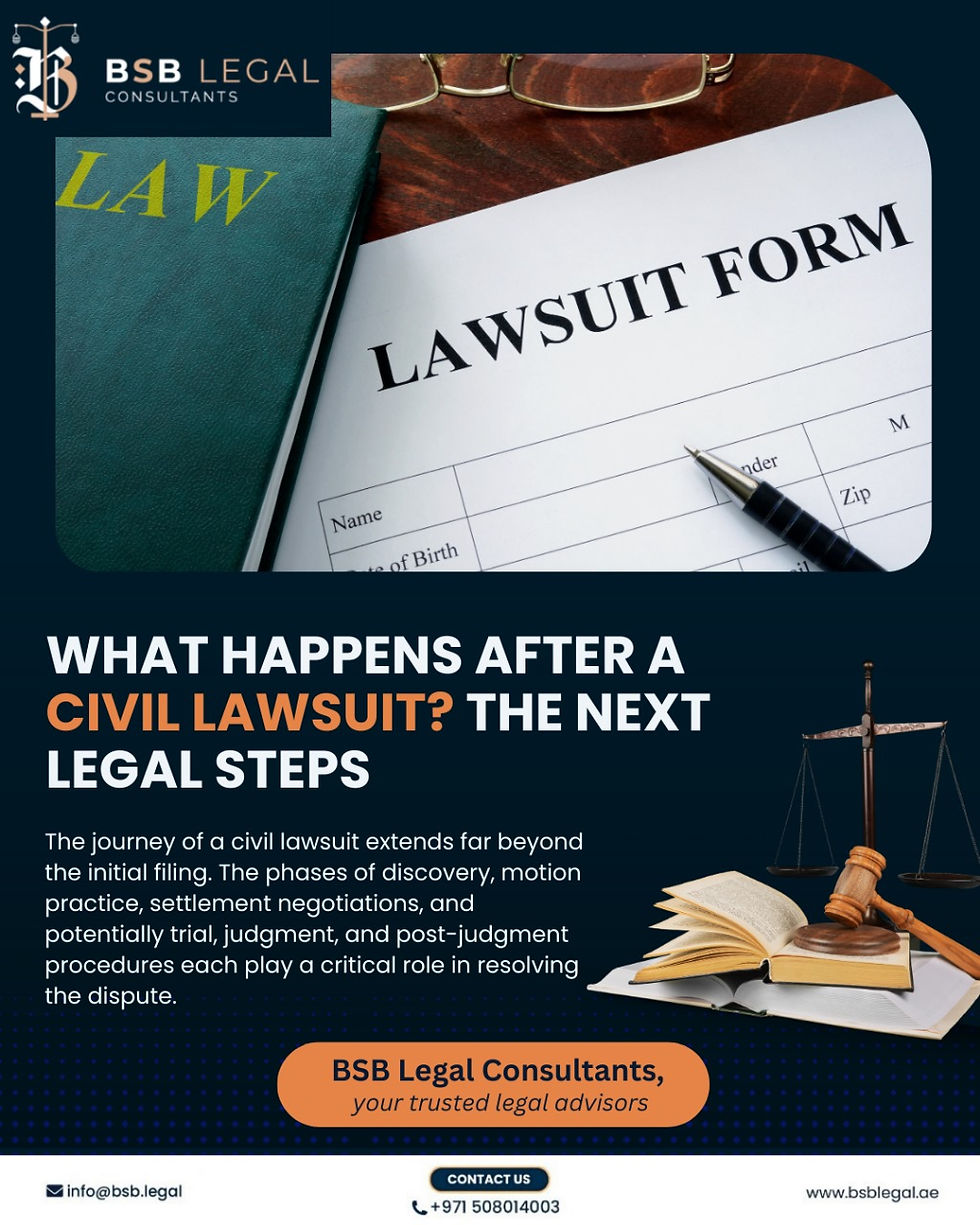What Happens After a Civil Lawsuit? The Next Legal Steps
- BSB Legal Consultants

- May 1
- 6 min read
Embarking on a civil lawsuit can feel like navigating a complex maze. Once the initial stages of filing and responding are complete, many individuals wonder, "What happens next?" Understanding the subsequent legal steps is crucial for both plaintiffs (those who initiated the lawsuit) and defendants (those being sued). This article will illuminate the typical path a civil lawsuit takes after the initial pleadings, providing a clear and informative overview of what to expect. Knowing these steps can empower you to better understand the process and work effectively with your civil lawyer.

Discovery: Unearthing the Facts
Following the initial exchange of documents (the complaint and the answer), the next significant phase is discovery. This is a formal process where both sides gather information and evidence relevant to the case. The goal of discovery is to prevent surprises at trial and to allow each party to assess the strengths and weaknesses of their opponent's case. Several tools are employed during discovery:
Interrogatories: These are written questions sent by one party to another, requiring written answers under oath. Interrogatories can help clarify facts, identify witnesses, and understand the opposing party's legal theories. For instance, in a personal injury civil lawsuit case, the defendant might send interrogatories asking about the details of the accident, the injuries sustained, and the medical treatment received. The plaintiff, in turn, might ask about the defendant's version of events and any potential negligence.
Requests for Production of Documents: This involves a party requesting the other to provide specific documents or tangible items relevant to the lawsuit. In a breach of contract civil lawsuit case, this could include the contract itself, emails, invoices, and financial records. A civil lawyer will carefully review these requests to ensure they are within the scope of the lawsuit and to gather crucial evidence for their client.
Depositions: These are out-of-court oral examinations of witnesses under oath, conducted by an attorney. A deposition allows lawyers to question witnesses, assess their credibility, and gather detailed testimony that can be used later in the case, including at trial. Your civil lawyer will prepare you thoroughly for your deposition if you are a witness and will skillfully question the opposing party's witnesses to uncover key information.
Requests for Admission: These are written statements sent to the opposing party, asking them to admit or deny specific facts related to the case. Matters admitted are considered proven for the purpose of the lawsuit, streamlining the issues that need to be litigated at trial.
The discovery phase can be time-consuming and often involves significant interaction between the parties and their legal counsel. A skilled civil lawyer will strategically utilize these discovery tools to build a strong case for their client.
Motion Practice: Addressing Legal Issues
Throughout the litigation process, either party may file motions with the court to address specific legal issues before trial. These motions can significantly impact the direction and outcome of the civil lawsuit. Some common types of motions include:
Motion to Dismiss: This motion, often filed by the defendant early in the case, argues that the lawsuit should be dismissed because it lacks a valid legal basis, even if the facts alleged by the plaintiff are true. For example, if the statute of limitations (the time limit for filing a lawsuit) has expired, a defendant might file a motion to dismiss.
Motion for Summary Judgment: This motion can be filed by either party after the discovery phase is complete. It argues that there is no genuine dispute of material fact and that the moving party is entitled to judgment as a matter of law. In essence, the moving party claims that the evidence is so clear that a trial is unnecessary. A civil lawyer will carefully analyze the evidence gathered during discovery to determine if a motion for summary judgment is appropriate.
Motions in Limine: These motions are typically filed shortly before trial to request that the court exclude certain evidence from being presented to the jury (or the judge in a bench trial). For instance, a party might file a motion in limine to exclude hearsay evidence or evidence that is unfairly prejudicial.
Motions to Compel Discovery: If one party fails to adequately respond to discovery requests, the other party can file a motion to compel, asking the court to order the non-compliant party to provide the requested information.
The court will hold hearings on these motions, where the attorneys for both sides present their arguments. The judge will then issue a ruling, which can significantly shape the future of the civil lawsuit case.
Settlement Negotiations and Mediation: Seeking Resolution Outside of Trial
While the legal process unfolds, the vast majority of civil lawsuit cases are resolved through settlement rather than proceeding to trial. Settlement involves an agreement reached between the parties to resolve the dispute outside of court. This can happen at any stage of the litigation process, even during or after trial.
Negotiation: This is the most common form of settlement, where the parties, often through their civil lawyers, communicate directly or indirectly to try and reach a mutually acceptable agreement. This can involve exchanging offers and counteroffers until a compromise is found.
Mediation: This is a more formal process involving a neutral third-party mediator who helps facilitate communication and negotiation between the parties. The mediator does not make a decision but assists the parties in exploring potential settlement options. Mediation is often a court-ordered or strongly encouraged step in civil lawsuit cases as it can be a cost-effective and efficient way to resolve disputes. A skilled mediator can help identify common ground and bridge gaps between the parties' positions.
Settlement offers numerous benefits, including saving time, reducing legal costs, and providing more control over the outcome compared to a trial where the decision rests with a judge or jury.
Trial: Presenting the Case in Court
If a settlement cannot be reached, the civil lawsuit will proceed to trial. This is a formal legal proceeding where both sides present their evidence and arguments to a judge or jury.
Jury Selection (if applicable): In many civil lawsuit cases, the parties have the right to a jury trial. The process of jury selection, known as voir dire, involves questioning potential jurors to identify any biases or conflicts of interest.
Opening Statements: Each party's civil lawyer will present an opening statement, outlining the facts they intend to prove and the legal arguments they will make.
Presentation of Evidence: The plaintiff presents their case first, calling witnesses and introducing documents and other evidence to support their claims. The defendant then has the opportunity to present their evidence and witnesses. Both sides can cross-examine the other party's witnesses. Rules of evidence govern what information can be presented to the court.
Closing Arguments: After all the evidence has been presented, each civil lawyer will deliver a closing argument, summarizing the evidence and arguing why their client should prevail.
Jury Instructions (if applicable): If there is a jury, the judge will instruct the jury on the relevant laws they must apply to the facts of the case.
Jury Deliberation (if applicable): The jury will then deliberate in private to reach a verdict.
Verdict: The jury (or the judge in a bench trial) will issue a verdict, finding in favor of the plaintiff or the defendant.
Judgment: The Court's Final Decision
Following a trial or a settlement, the court will issue a judgment. This is the final decision of the court in the civil lawsuit case.
Judgment After Trial: If the plaintiff wins at trial, the judgment will typically specify the relief granted, such as monetary damages to be paid by the defendant. If the defendant wins, the judgment will state that the plaintiff's claims are dismissed.
Judgment by Settlement: If the parties reach a settlement agreement, they will typically submit a proposed judgment to the court reflecting the terms of their agreement. Once the judge approves and signs it, it becomes a legally binding judgment.
Post-Judgment Procedures: Enforcement and Appeals
The conclusion of a trial and the issuance of a judgment do not necessarily mark the absolute end of the legal process.
Enforcement of Judgment: If the plaintiff wins a monetary judgment and the defendant does not voluntarily pay, the plaintiff may need to take steps to enforce the judgment. This can involve various legal tools, such as wage garnishment, bank levies, or property liens. A civil lawyer can assist the plaintiff in navigating these enforcement procedures.
Appeals: The losing party in a civil lawsuit generally has the right to appeal the judgment to a higher court. An appeal is not a retrial but rather a review of whether the lower court made any legal errors. The appellate court will examine the record of the trial and the legal arguments presented by both sides. They can affirm the lower court's decision, reverse it, or send the case back for further proceedings.
Conclusion
The journey of a civil lawsuit extends far beyond the initial filing. The phases of discovery, motion practice, settlement negotiations, and potentially trial, judgment, and post-judgment procedures each play a critical role in resolving the dispute. Understanding these steps is essential for anyone involved in a civil lawsuit case. Engaging a competent civil lawyer is paramount to effectively navigate this complex legal landscape, protect your rights, and strive for the best possible outcome. Whether through skillful negotiation or vigorous representation in court, your attorney will guide you through each stage, ensuring you are informed and well-represented.



Comentários